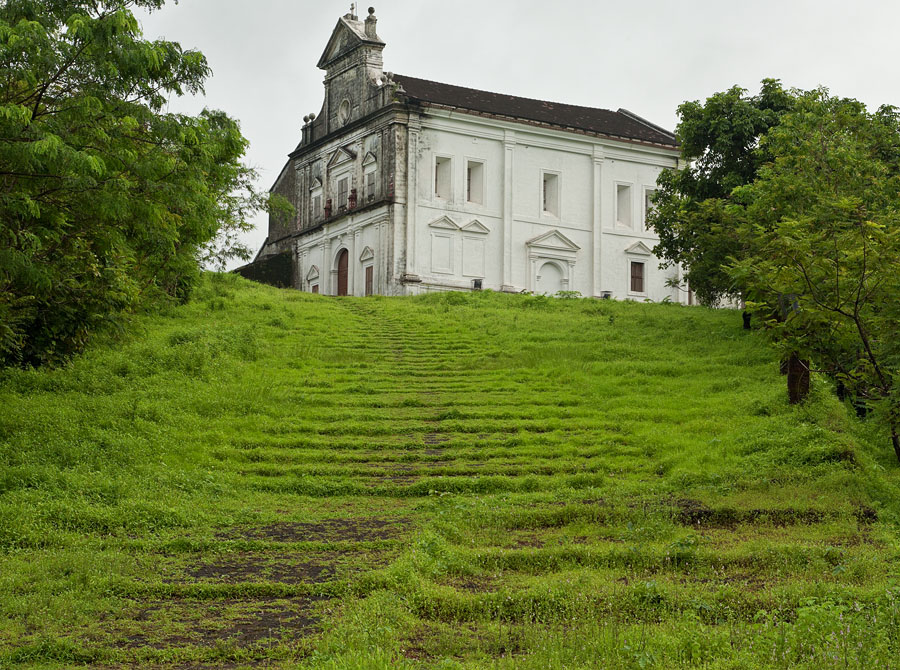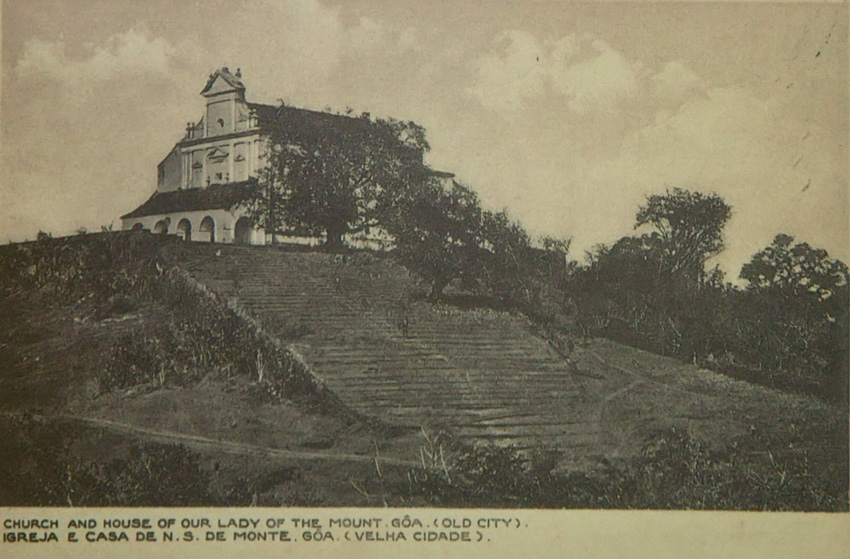When Afonso de Albuquerque first tried to claim Goa in 1510, his men encountered fierce resistance from Adil Shah’s forces from their vantage point atop a hillock in Old Goa. Stunned by the intensity of the opposition Albuquerque was forced to retreat. But he was to return in a few months and dislodge Adil Shah. Albuquerque did not forget the high ground from where he had been barraged. After his triumph, he erected a hermitage on the hillock in honour of Mary which later morphed into a chapel known to us now as the Chapel of Our Lady of the Mount. This was originally the site of an old Hindu temple. Albuquerque was known to have sought cooperation of the Hindus in his fight against the Muslims.
From its perch there are sweeping vistas to be enjoyed. The island of Divar to the north across River Mandovi is a picture of serenity, and to the west are the monuments of Old Goa. The chapel recently underwent restoration with funding from Fundação Oriente.
I dig this locale for its vistas and for the solitude it provides for quiet contemplation. But it won’t remain that way for long. The adjacent forest at the foot of the hillock has been depleted and is being primed for construction. Shame on Goans!
The final image in this series is a photograph of a photograph from the archives collection of Central Library in Panjim.

Chapel of Mount Mary at Old Goa, Goa
5D Mark III, 70-200L f/2.8 IS II

Chapel of Our Lady of the Mount during the monsoon
5D, 24-105L

Chapel of Our Lady of the Mount after the monsoon
5D II, 24-105L

Chapel of Our Lady of the Mount c. 1925 (© Souza and Paul)





[…] second image below was taken from the hill at the Chapel of Mount Mary overlooking the Mandovi river. To the left of the frame is the Church of St Francis of Assisi. […]
rajan sir
i would like to add 1 more thing to ur discussion, i am from divar and i have many evidence which clearly says portuguese have distroyed our temples,i can show u n numbers of proofs to those who still dont agree or believe to it.
also i would like to mention the Maharashtran and north indians are our brothers and these protuguse are outsiders.who distroyed hindu culture because of which still we r suffering. still some people in my village they speak Portuguese language and feel shy in speaking hindi……….. shame to all those people
interesting photos… i like the colors very much 🙂
Naqueles tempos era vulgar o vencedor destruir os deuses dos vencidos e a guerra era feita em nome da religião.Já no império romano era assim e depois no feudalismo para cristianização dos pagãos na Europa procedeu-se da mesma maneira, destruindo os ídolos ou convertendo-os em santas ou santos cristãos. Eram tempos da mentalidade feudal. Criticar hoje o passado é perda do tempo, um erro, pois o passado nos serve para não repetirmos os erros e sermos melhores cidadãos do mundo ou do país. Hoje vivemos num mundo globalizado e consideramos o mundo como uma aldeia porque as comunicações são tão rapidas que pudemos-nos viajar dum sítio para o outro em questão de horas. Hoje devemos respeitar o homem e a natureza,conservar o património natural e o património criado, manter a harmonia entre todos as religiões e aceitarmos uns aos outros sem imposições forçadas. Gosto do seu blog porque realmente é isso que está defender e chamar a atenção dos interessados para defender a herança recebida dos antecessores, sejam hindus, budistas, muçulmanos e finalmente, os cristãos. Hoje devemos reconhecer que o Estado Portugues da Índia, apesar dos seus erros, fez muitas coisas boas: os limites actuais de Goa foram feitos com o sangue, suor e lágrimas das suas gerações, bem como as nossas cidades, Velha Goa, Pangim, Margão, Vasco de Gama, Bardez, etc..e tantas obras de arquitectura e jardins dignas de grande mérito e, sobretudo, o bom planeamneto urbanistico sem prejudicar o meio ambiente…bem como os trabalhos em defesa da promoção da agricultura e transplantação das árvores de fruta dum continente para o outro, feita pelos descobridores e jesuítas, ligados ao Estado da India Portuguesa.
[…] Chapel on the Hill » Photo Blog by Rajan Parrikar […]
This is a photography blog, with a connection to history because of the subject matter and because Rajan has also retrieved old historical photographs – which lends an additional dimension to this blog.
There is a history to the site of this photograph that exists, accept it or deny it, or seek to “mitigate” it like jc did. The only useful lesson of history is that we must defend the worthwhile things that we create – there are too many forces out there that will happily destroy them.
Dear Rajan,
Please stand corrected. Portuguese did not seek help of Hindus. It was the Hindus who approached the Portuguese to over throw the muslims. There still exist some Hindus who are inviting Maharashtrians and North Indians into Goa to decimate christian influence. It was not the christians who brought the Portuguese but fellow Hindus who exposed their own bretheren to trouble.
-Soter
Dear Rajan-bab,
Thanks for the courtesy of your reply.
If one understands ‘religion’ in the context of power and control, the way I do, one will come to the same conclusion as I have personally reached i.e. those in quest of power will destroy any symbol or centre which does not submit to it. Those that submit are absorbed within the power structure, albeit at varying levels on the power-ladder.
This would not be a novel idea. And no one people has been immune from this effect of power + land grab.
As far as the magnitude of the problem, it is possible for it to be debatable. Personally, I am not sure if ALL the events were recorded, and that too recorded in a non-partisan fashion. For, those who record history, tend to glorify their own and demonify the other side.
So, one has to fall back on a reasonable explanation as to why the Buddhist shrines almost disappeared from the subcontinent; that too, before the arrival of the Muslims.
Accordingly, I disagree with you but I accept that the past is what one learns from – so that one does not repeat the evils of our forebears.
good wishes
jc
Dear JC-bab,
Very briefly (since this is a photography blog) –
There is NO symmetry in the business of destroying religious places of worship. The number of Hindu places of worship destroyed by the Muslims and Portuguese is so large that it is meaningless to even compare them with Hindus destroying other peoples’ places of worship. Furthermore, there is a BIG difference: the Portuguese and Muslims destroyed Hindu temples because Hindus were idolators, because Hindus worshipped a ‘false God’, because they wanted to convert Hindus to their Book. The relatively insignificant instances of Hindu kings destroying other places of worship were almost always in warfare, where mosque or temple destruction might have been collateral damage and not targeted/deliberate religious desecration.
Warm regards,
Rajan
Dear Rajan
Thanks for the photograph and the amendment of the script. There is no need to give undue credit (in this case, discredit) to the Portuguese.
The business of Hindus destroying mosques and Muslims destroying temples was well afoot in Goa (Old Goa) during the era of the various Hindu v Muslim regimes which fought over this important port on the West Coast of the subcontinent.
It might be worth asking: Was Goa never under the Buddhists (as in Ashoka)? Did they never construct places of worship? What happened to them?